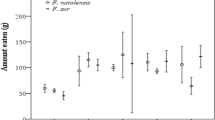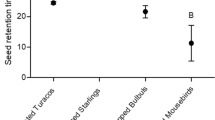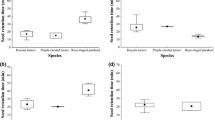Abstract
Frugivorous birds are important in the dispersal of many fleshy-fruited plant species, including invasive plants. Consequently, we investigated three native frugivorous avian species’ role in potential dispersal and germination success of the invasive American bramble (Rubus cuneifolius) in South Africa, particularly in terms of amount of fruit ingested, transit time, and their effects on seed germination. Three common species of frugivorous bird species were predicted to positively affect the spread of invasive R. cuneifolius. The bird species (speckled mousebirds Colius striatus, red-winged starlings Onychognathus morio and dark-capped bulbuls Pycnonotus tricolor) were fed R. cuneifolius fruit in captivity and amounts ingested were determined together with transit times. Seeds that were excreted and/or regurgitated by the three bird species, manually extracted seeds, and control whole fruit were then planted and their germination assessed daily. Although the three bird species varied in the amount of fruit consumed (~ 10–30 g), there was no significant difference in amount of R. cuneifolius fruit eaten per gram body mass among the species. Bird-ingested seeds emerged a mean 21–23 days after planting, while the seeds from the whole fruit took longer to emerge (mean 28 days). Germination of seeds ingested by the respective bird species was significantly higher (~ 60–75%) than seeds manually removed from fruits (~ 52%) or seeds in whole fruits (~ 7%). This suggests that removal of pulp and seed coat abrasion by the birds increased germination success. The three bird species all had R. cuneifolius seed transit times greater than 20 min, demonstrating their potential to disperse seeds a distance away from the parent plant. The results showed that the three bird species increased the germination success and suggests they are potentially important dispersers of the invasive R. cuneifolius.






Similar content being viewed by others
References
Barnea A, Yom-Tov Y, Friedman J (1990) Differential germination of two closely related species of Solanum in response to bird ingestion. Oikos 57:222–228
Barnea A, Yom-Tov Y, Friedman J (1991) Does ingestion by birds affect seed germination? Funct Ecol 5:394–402
Buckley YM, Anderson S, Catterall CP, Corlett RT, Engel T, Gosper CR, Nathan R, Richardson DM, Setter M, Spiegel O (2006) Management of plant invasions mediated by frugivore interactions. J Appl Ecol 43:848–857
Cain ML, Milligan BG, Strand AE (2000) Long-distance seed dispersal in plant populations. Am J Bot 87:1217–1227
Charalambidou I, Santamaria L, Langevoord O (2003) Effect of ingestion by five avian dispersers on the transit time, retrieval and germination of Ruppia maritima seeds. Funct Ecol 17:747–753
Chimera CG, Drake DR (2010) Effects of pulp removal on seed germination of five invasive plants in Hawaii. Plant Prot Q 25:137
Clergeau P (1992) The effect of birds on seed germination of fleshy-fruited plants in temperate farmland. Acta Oecol 13:679–686
Craig A (2005) Red-winged starling. In: Hockey P, Dean W, Ryan P (eds) Robert’s birds of Southern Africa, VII edn. Trustees of the John Voelcker Bird Book Fund, Cape Town, pp 961–962
Craig A, Feare C (2010) Starlings and Mynas. A&C Black, Barcelona
Cypher BL, Cypher EA (1999) Germination rates of tree seeds ingested by coyotes and raccoons. Am Midl Nat 142:71–76
D’Avila G, Gomes-Jr A, Canary AC, Bugoni L (2010) The role of avian frugivores on germination and potential seed dispersal of the Brazilian pepper Schinus terebinthifolius. Biota Neotrop 10:45–51
Day MD, Wiley CJ, Playford J, Zalucki MP (2003) Lantana: current management status and future prospects. ACIAR, Canberra
Dean WR (2005) Speckled mousebird. In: Hockey P, Dean W, Ryan P (eds) Robert’s birds of Southern Africa, VII edn. Trustees of the John Voelcker Bird Book Fund, Cape Town, pp 197–198
Denny R, Goodall J (1991) Variable effects of glyphosate and triclopyr used for the control of American bramble, Rubus cuneifolius Agg, in pine plantations. S Afr Forest J 159:11–15
Dlamini P, Zacharides C, Downs CT (2018) The effect of frugivorous birds on seed dispersal and germination of the invasive Brazilian pepper tree (Schinus terebinthifolius) and Indian laurel (Litsea glutinosa). S Afr J Botany 114:61–68
Dovrat G, Perevolotsky A, Ne’eman G (2012) Wild boars as seed dispersal agents of exotic plants from agricultural lands to conservation areas. J Arid Environ 78:49–54
Downs CT (2008) Aspects of diet choice and digestion in the dark-capped bulbul Pycnonotus barbatus. Ostrich 79:73–78
Downs CT, Wirminghaus JO, Lawes MJ (2000) Anatomical and nutritional adaptations of the speckled mousebird (Colius striatus). Auk 117:791–794
Ellstrand NC, Schierenbeck KA (2000) Hybridization as a stimulus for the evolution of invasiveness in plants? Proc Nat Acad Sci 97:7043–7050
Erasmus DJ (1984) A.3 Bramble. Weeds: Farming in South Africa. Department of Agriculture, Pretoria, South Africa
Ezemvelo KZN Wildlife (2016) Alien and invasive species management plan for the Maloti-Drakensberg Park World Heritage Site. Unpublished Management Plan, Pietermaritzburg
Fishpool L, Tobias J (2005) Family Pycnonotidae (Bulbuls). Handb Birds World 10:124–253
Fricke EC, Simon MJ, Reagan KM, Levey DJ, Riffell JA, Carlo TA, Tewksbury JJ (2013) When condition trumps location: seed consumption by fruit-eating birds removes pathogens and predator attractants. Ecol Lett 16:1031–1036
Henderson L (2011) Rubus species—morphology, taxonomy. Southern African plant Invader Atlas News No. 19, ARC-PPRI Weeds Research Programme, 9 pp
Herrera CM (1981) Are tropical fruits more rewarding to dispersers than temperature ones? Am Nat 118:896–907
Hui C, Richardson DM (2017) Invasion dynamics. Oxford University Press, Oxford
Hummer KE (1996) Rubus diversity. HortScience 31:182–183
Invasive Species South Africa (2017) http://www.invasives.org.za/legislation/item/337-american-bramble-rubus-cuneifolius. Downloaded June 2017
Jordaan LA, Downs CT (2012) Comparison of germination rates and fruit traits of indigenous Solanum giganteum and invasive Solanum mauritianum in South Africa. S Afr J Bot 80:13–20
Jordaan L, Johnson SD, Downs CT (2011a) The role of avian frugivores in germination of seeds of fleshy-fruited invasive alien plants. Biol Invasions 13:1917–1930
Jordaan LA, Johnson SD, Downs CT (2011b) Digestion of fruit of invasive alien plants by three southern African avian frugivores. Ibis 153:863–867
Jordaan LA, Johnson SD, Downs CT (2012) Wahlberg’s Epauletted Fruit Bat (Epomophorus wahlbergi) as a potential dispersal agent for fleshy-fruited invasive alien plants: effects of handling behaviour on seed germination. Biol Invasions 14:959–968
Jordano P (1983) Fig-seed predation and dispersal by birds. Biotropica 15:38–41
Kueffer C, Kronauer L, Edwards PJ (2009) Wider spectrum of fruit traits in invasive than native floras may increase the vulnerability of oceanic islands to plant invasions. Oikos 118:1327–1334
Lloyd P (2005) Dark-capped bulbul. In: Hockey P, Dean W, Ryan P (eds) Robert’s birds of Southern Africa, VII edn. Trustees of the John Voelcker Bird Book Fund, Cape Town, pp 766–767
Martin-Albarracin VL, Nuñez MA, Amico GC (2018) Non-redundancy in seed dispersal and germination by native and introduced frugivorous birds: implications of invasive bird impact on native plant communities. Biodivers Conserv 27:3793
Mokotjomela TM, Hoffmann JH, Downs CT (2015) The potential for birds to disperse the seeds of Acacia cyclops, an invasive alien plant in South Africa. Ibis 157:449–458
Mokotjomela T, Downs CT, Esler K, Knight J (2016) Seed dispersal effectiveness: a comparison of four bird species feeding on seeds of invasive Acacia cyclops in South Africa. S Afr J Botany 105:259–263
Moles AT, Drake DR (1999) Post-dispersal seed predation on eleven large-seeded species from the New Zealand flora: a preliminary study in secondary forest. New Zeal J Bot 37:679–685
Moore PD (2001) Ecology: the guts of seed dispersal. Nature 414:406–407
Morris M, Wood A, Den Breeÿen A (1999) Plant pathogens and biological control of weeds in South Africa: a review of projects and progress during the last decade. Afr Entom Mem 1:129–137
Murray KG, Russell S, Picone CM, Winnett-Murray K, Sherwood W, Kuhlmann ML (1994) Fruit laxatives and seed passage rates in frugivores: consequences for plant reproductive success. Ecology 75:989–994
Olckers T (1999) Biological control of Solanum mauritianum Scopoli (Solanaceae) in South Africa: a review of candidate agents, progress and future prospects. Afr Entom Mem 1:65–73
Olckers T (2004) Targeting emerging weeds for biological control in South Africa: the benefits of halting the spread of alien plants at an early stage of their invasion: working for water. S Afr J Sci 100:64–68
Panetta F (2001) Seedling emergence and seed longevity of the tree weeds Celtis sinensis and Cinnamomum camphora. Weed Res 41:83–95
Panetta F, McKee J (1997) Recruitment of the invasive ornamental, Schinus terebinthifolius, is dependent upon frugivores. Austr J Ecol 22:432–438
Parsons W, Cuthbertson E (1992) Noxious weeds of Australia. Inkata Press, Melbourne
Paulsen T, Högstedt G (2002) Passage through bird guts increases germination rate and seedling growth in Sorbus aucuparia. Funct Ecol 16:608–616
Pollard AD (2013) The potential use of fire as a means of large-scale control of American bramble (Rubus cuneifolius), in the uKhahlamba Drakensberg Park. Unpublished Honours thesis, University of Stellenbosch
Pyšek P, Hulme PE (2005) Spatio-temporal dynamics of plant invasions: linking pattern to process. Ecoscience 12:302–315
Renne IJ, Gauthreaux SA Jr, Gresham CA (2000) Seed dispersal of the Chinese tallow tree (Sapium sebiferum (L.) Roxb.) by birds in coastal South Carolina. Am Midl Nat 144:202–215
Richardson DM, Van Wilgen BW (2004) Invasive alien plants in South Africa: how well do we understand the ecological impacts? Working for Water. S Afr J Sci 100:45–52
Richardson DM, Allsopp N, D’antonio CM, Milton SJ, Rejmanek M (2000) Plant invasions—the role of mutualisms. Biol Rev 75:65–93
SABAP2 Southern African Bird Atlas Project (2019) Viewed 5 October 2019, http://sabap2.adu.org.za/
Sochor M (2018) Preliminary taxonomic treatment of eastern South African Rubus. Unpublished report, 44 pp
Southern African Plant Invaders Atlas (SAPIA) Database (2016) Plant Protection and Research Institute, Agricultural Research Council, viewed 16 August 2016, from http://www.arc.agric.za/arc-ppri/Pages/Weeds%20Research/Geographical-distribution-of-IAPs-in-southern-Africa-(SAPIA)-.aspx
Symes CT, Downs CT (2001) Feeding and energy intake in two avian frugivores, the blackeyed bulbul Pycnonotus barbartus and speckled mousebird Colius striatus. Durban Mus Novit 26:20–24
Symes CT, Nicolson SW, McKechnie AE (2008) Response of avian nectarivores to the flowering of Aloe marlothii: a nectar oasis during dry South African winters. J Ornith 149:13–22
Thabethe V, Wilson A-L, Hart L, Downs CT (2015) Ingestion by an invasive parakeet species reduces germination success of invasive alien plants relative to ingestion by indigenous turaco species in South Africa. Biol Invasions 17:1–11
Thibault M, Masse F, Pujapujane A, Lannuzel G, Bordez L, Potter MA, Fogliani B, Vidal E, Brescia F (2018) “Liaisons dangereuses”: the invasive red-vented bulbul (Pycnonotus cafer), a disperser of exotic plant species in New Caledonia. Ecol Evol 18:9259–9269
Traveset A, Willson MF (1997) Effect of birds and bears on seed germination of fleshy-fruited plants in temperate rainforests of southeast Alaska. Oikos 80:89–95
Traveset A, Riera N, Mas RE (2001) Ecology of fruit-colour polymorphism in Myrtus communis and differential effects of birds and mammals on seed germination and seedling growth. J Ecol 89:749–760
Van Kleunen M, Johnson SD (2007) South African Iridaceae with rapid and profuse seedling emergence are more likely to become naturalized in other regions. J Ecol 95:674–681
Wilson A-L, Downs CT (2012) Knysna Turacos (Tauraco corythaix) do not improve seed germination of ingested fruit of some indigenous South African tree species. S Afr J Bot 78:55–62
Witmer MC, Cheke AS (1991) The dodo and the tambalacoque tree: an obligate mutualism reconsidered. Oikos 61:133–137
Yagihashi T, Hayashida M, Miyamoto T (1998) Effects of bird ingestion on seed germination of Sorbus commixta. Oecologia 114:209–212
Yagihashi T, Hayashida M, Miyamoto T (1999) Effects of bird ingestion on seed germination of two Prunus species with different fruit-ripening seasons. Ecol Res 14:71–76
Acknowledgements
Special thanks to the Department of Water and Sanitation (ZA) for providing funding to KLM. We thank E. Ally and A. Young for technical assistance. We are grateful to P. Singh and C. Munyai for assisting with data analyses. We are grateful for financial support from the National Research Foundation (ZA) and DST-NRF Centre for Invasion Biology, University of Stellenbosch. Birds were caught and kept in captivity under Permit OP485-2016 issued by Ezemvelo KZN Wildlife, and experimental procedures approved by the UKZN Ethics Committee (Authorisation number 020/15/animal). We are most grateful for the constructive comments of the reviewers.
Author information
Authors and Affiliations
Corresponding author
Additional information
Publisher's Note
Springer Nature remains neutral with regard to jurisdictional claims in published maps and institutional affiliations.
Rights and permissions
About this article
Cite this article
Molefe, K.L., Tedder, M.J., Thabethe, V. et al. Role of native avian frugivores in germination facilitation and potential dispersal of invasive American bramble (Rubus cuneifolius) in South Africa. Biol Invasions 22, 1109–1120 (2020). https://doi.org/10.1007/s10530-019-02164-w
Received:
Accepted:
Published:
Issue Date:
DOI: https://doi.org/10.1007/s10530-019-02164-w




